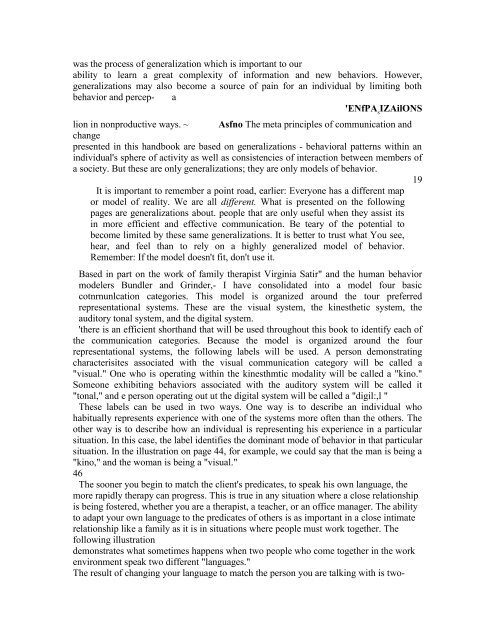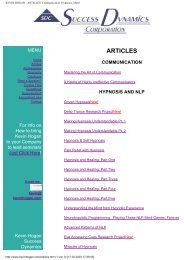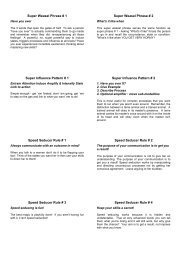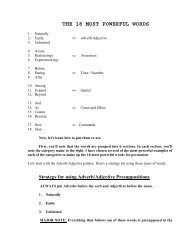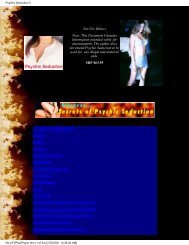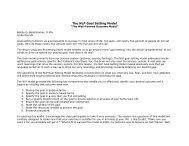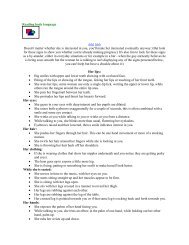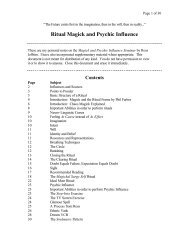A Pragmatic Guide To Communication & Change.pdf - NLP Info Centre
A Pragmatic Guide To Communication & Change.pdf - NLP Info Centre
A Pragmatic Guide To Communication & Change.pdf - NLP Info Centre
- No tags were found...
You also want an ePaper? Increase the reach of your titles
YUMPU automatically turns print PDFs into web optimized ePapers that Google loves.
was the process of generalization which is important to our<br />
ability to learn a great complexity of information and new behaviors. However,<br />
generalizations may also become a source of pain for an individual by limiting both<br />
behavior and percep- a<br />
'ENfPA s<br />
IZAilONS<br />
lion in nonproductive ways. ~ Asfno The meta principles of communication and<br />
change<br />
presented in this handbook are based on generalizations - behavioral patterns within an<br />
individual's sphere of activity as well as consistencies of interaction between members of<br />
a society. But these are only generalizations; they are only models of behavior.<br />
19<br />
It is important to remember a point road, earlier: Everyone has a different map<br />
or model of reality. We are all different. What is presented on the following<br />
pages are generalizations about. people that are only useful when they assist its<br />
in more efficient and effective communication. Be teary of the potential to<br />
become limited by these same generalizations. It is better to trust what You see,<br />
hear, and feel than to rely on a highly generalized model of behavior.<br />
Remember: If the model doesn't fit, don't use it.<br />
Based in part on the work of family therapist Virginia Satir" and the human behavior<br />
modelers Bundler and Grinder,- I have consolidated into a model four basic<br />
cotnrnunlcation categories. This model is organized around the tour preferred<br />
representational systems. These are the visual system, the kinesthetic system, the<br />
auditory tonal system, and the digital system.<br />
'there is an efficient shorthand that will be used throughout this book to identify each of<br />
the communication categories. Because the model is organized around the four<br />
representational systems, the following labels will be used. A person demonstrating<br />
characterisites associated with the visual communication category will be called a<br />
"visual." One who is operating within the kinesthmtic modality will be called a "kino."<br />
Someone exhibiting behaviors associated with the auditory system will be called it<br />
"tonal," and e person operating out ut the digital system will be called a "digil:,l "<br />
These labels can be used in two ways. One way is to describe an individual who<br />
habitually represents experience with one of the systems more often than the others. The<br />
other way is to describe how an individual is representing his experience in a particular<br />
situation. In this case, the label identifies the dominant mode of behavior in that particular<br />
situation. In the illustration on page 44, for example, we could say that the man is being a<br />
"kino," and the woman is being a "visual."<br />
46<br />
The sooner you begin to match the client's predicates, to speak his own language, the<br />
more rapidly therapy can progress. This is true in any situation where a close relationship<br />
is being fostered, whether you are a therapist, a teacher, or an office manager. The ability<br />
to adapt your own language to the predicates of others is as important in a close intimate<br />
relationship like a family as it is in situations where people must work together. The<br />
following illustration<br />
demonstrates what sometimes happens when two people who come together in the work<br />
environment speak two different "languages."<br />
The result of changing your language to match the person you are talking with is two-


